External links
| This article about an organisation in the United Kingdom is a stub. You can help Wikipedia by expanding it. |
The Somerset Buildings Preservation Trust (SBPT) works to save the architectural heritage of Somerset, England.
The Trust is an independent body and consists of up to 18 Trustees who hold Board meetings 3 times a year. It is a Building Preservation Trust with charitable status and a company limited by guarantee. The Trust consists of up to 2 elected councillors nominated by the Somerset County Council and 5 elected councillors nominated by the District Councils in Somerset
Since 1988 the SBPT has restored and converted a number of historic buildings:
The Trust has co-ordinated a £550,000 renovation project to turn the Tithe Barn at Dunster Priory into a community hall. [1] [2]
| This article about an organisation in the United Kingdom is a stub. You can help Wikipedia by expanding it. |
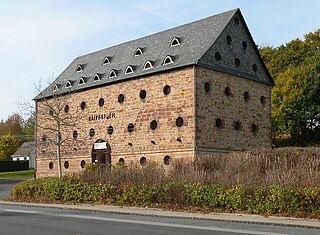
A tithe barn was a type of barn used in much of northern Europe in the Middle Ages for storing rents and tithes. Farmers were required to give one-tenth of their produce to the established Church. Tithe barns were usually associated with the village church or rectory, and independent farmers took their tithes there. The village priests did not have to pay tithes—the purpose of the tithe being their support. Some operated their own farms anyway. The former church property has sometimes been converted to village greens.

Somerton is a town and civil parish in the English county of Somerset. It gave its name to the county and was briefly, around the start of the 14th century, the county town, and around 900 was possibly the capital of Wessex. It has held a weekly market since the Middle Ages, and the main square with its market cross is today an attractive location for visitors. Situated on the River Cary, approximately 8.8 miles (14.2 km) north-west of Yeovil, Somerton has its own town council serving a population of 4,697 as of 2011.
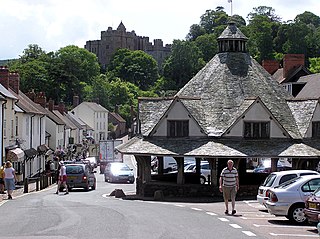
Dunster is a village, civil parish and former manor within the English county of Somerset, today just within the north-eastern boundary of the Exmoor National Park. It lies on the Bristol Channel coast 2.5 miles (4 km) south-southeast of Minehead and 20 miles (32 km) northwest of Taunton. The United Kingdom Census of 2011 recorded a parish population of 817.
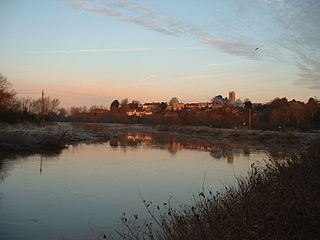
Langport is a small town and civil parish in Somerset, England, 5 miles (8.0 km) west of Somerton in the South Somerset district. The parish has a population of 1,081. Langport is contiguous with Huish Episcopi, a separate parish that includes much of the town's outskirts.

Goathurst is a small village and civil parish in the English county of Somerset, around 3 miles from the town of Bridgwater. The parish includes the hamlets of Andersfield and Huntstile. The village is on the route of the Samaritans Way South West.

The Temple of Harmony is an 18th-century folly in the grounds of Halswell House, Goathurst, Somerset, England. Built in 1767, it is a replica of the 1st-century Temple of Fortuna Virilis in Rome. The Temple stands in Mill Wood, a 17-acre pleasure garden in the grounds of Halswell House, and was built for Sir Charles Kemeys-Tynte in 1767 to designs by Thomas Prowse, with features by Robert Adam and Thomas Stocking. The Temple was dedicated to the memory of a mutual friend, Peregrine Palmer, formerly MP for Oxford University.

The Warehouse in Great Bow Yard Langport, Somerset, England is an example of Victorian industrial architecture.

The Tithe Barn is a 14th-century tithe barn in Dunster, Somerset, England.
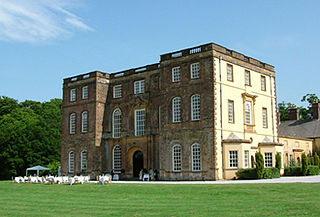
Halswell House is a Grade I listed country house in Goathurst, Somerset, England.

East Quantoxhead is a village in the district of Somerset West and Taunton, 3 miles (5 km) from West Quantoxhead, 4 miles (6 km) east of Williton, and 13 miles (21 km) west of Bridgwater, within the Quantock Hills Area of Outstanding Natural Beauty in Somerset, England.

Selworthy is a small village and civil parish 5 kilometres (3 mi) from Minehead in Somerset, England. It is located in the National Trust's Holnicote Estate on the northern fringes of Exmoor. The parish includes the hamlets of Bossington, Tivington, Lynch, Brandish Street and Allerford.
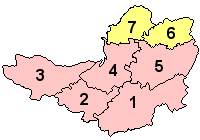
The Grade I listed buildings in Somerset, England, demonstrate the history and diversity of its architecture. The ceremonial county of Somerset consists of a non-metropolitan county, administered by Somerset County Council, which is divided into five districts, and two unitary authorities. The districts of Somerset are West Somerset, South Somerset, Taunton Deane, Mendip and Sedgemoor. The two administratively independent unitary authorities, which were established on 1 April 1996 following the breakup of the county of Avon, are North Somerset and Bath and North East Somerset. These unitary authorities include areas that were once part of Somerset before the creation of Avon in 1974.

The Bishop's Barn in Silver Street, Wells, Somerset, England, was built as a tithe barn in the 15th century. It has been designated as a Grade I listed building, and scheduled as an ancient monument.

The Yarn Market in Dunster, Somerset, England was built in the early 17th century. It has been designated as a Grade I listed building and scheduled monument. Dunster was an important market place in the Middle Ages particularly following the construction of Dunster Castle and the establishment of the Priory Church of St George.

The Merchant's House at Number 8, Market Place, Shepton Mallet, Somerset, England was built around 1675 and has been designated as a Grade II* listed building. The date of construction was confirmed by dendrochronology.
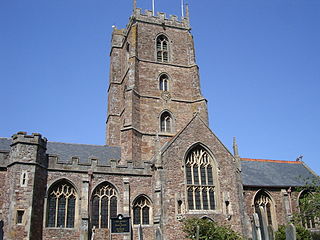
Dunster Priory was established as a Benedictine monastery around 1100 in Dunster, Somerset, England.

There are over 670 scheduled monuments in the ceremonial county of Somerset in South West England. The county consists of a non-metropolitan county, administered by Somerset County Council, which is divided into five districts, and two unitary authorities. The districts of Somerset are West Somerset, South Somerset, Taunton Deane, Mendip and Sedgemoor. The two administratively independent unitary authorities, which were established on 1 April 1996 following the breakup of the county of Avon, are North Somerset and Bath and North East Somerset. These unitary authorities include areas that were once part of Somerset before the creation of Avon in 1974.